Whether life gives us lemons or lemonades, it’s always better when you have a friend to share your ups and downs with – and that applied to the Brontës too. Of course Anne, Emily and Charlotte themselves were close and loving sisters, but they wouldn’t be human if they hadn’t also experienced sibling rivalries or arguments from time to time. Although these sororal relationships understandably command our attention, it’s nice to know that they had friends from outside the parsonage as well, and that point was brought into a sharp, and lovely, focus as I scoured a newspaper archive recently.
The Manchester Evening News of 23rd October 1895 carried a story on a ‘Brontë relic’:
“The Brontë Society have just acquired by gift a small but interesting article in the shape of a needlecase presented to a relative of Miss Dixon, of Lancaster, by Maria Brontë, the eldest sister of the Brontës. The relative, a school-girl named Margaret, was a fellow scholar at Casterton-School with Maria Brontë, and the little gift bears an inscription by Maria Brontë. This is the only known specimen of her handwriting. Maria Brontë, who died young, will be remembered as the original of ‘Helen Burns.’”
The article is incorrect in that Maria had tragically died before the school moved from Cowan Bridge to Casterton, and there was no picture of the artefact, but I’ve tracked it down and here it is, very touching proof that even at the deadly Cowan Bridge, maltreated Maria had a friend by her side. Made of ivory coloured cardboard, with a ribbon seen here across the centre, it has an embossed design in a classic Greek style, and more importantly Maria’s loving words: ‘To my dear Margaret from her affectionate schoolfellow Maria Brontë.’
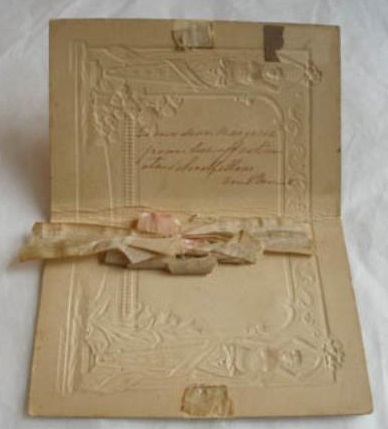
It was at a later school that Charlotte made her great lifelong friends in Ellen Nussey and Mary Taylor. Roe Head was thankfully very different to Cowan Bridge, and whilst Charlotte had at first to struggle to defeat her shyness, she eventually made other friends as well as the two mentioned above who will always be associated with her. Perhaps foremost among these was Leah Brooke of Aldam’s House, Dewsbury. Like Mary Taylor, Leah was the daughter of a wealthy wool merchant, but also like Mary the family fortunes were reversed by bankruptcy, showing the precarious nature of business at this time. Like Charlotte, Leah also died in 1855.
There was intense speculation a few years ago that Charlotte Brontë had formed a close friendship with a pupil of hers after returning to Roe Head as a teacher, but I believe we can now clear up that misunderstanding. A page of Charlotte Brontë’s prayerbook was found to contain a pencilled inscription from an Ann Cook, reading: ‘Pray don’t forget me my sweet little thing, A.C.’
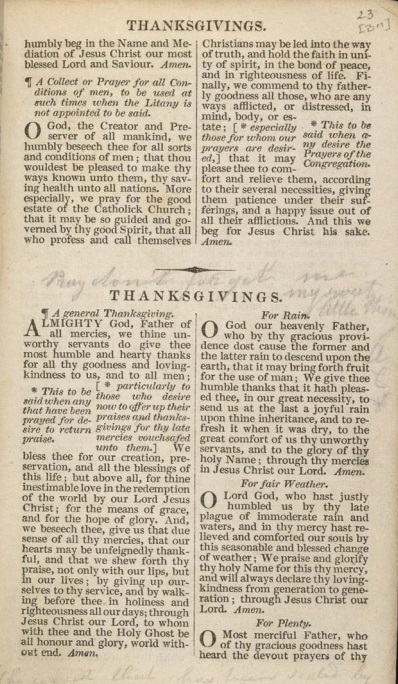
The discovery of this loving inscription sent the rumour mill, unfairly in my opinion, into overdrive, but I believe a letter sent from Ellen Nussey to Elizabeth Gaskell after Charlotte’s death clears the matter up. Ellen writes:
”I enclose also a notice which dear C. made in a letter on the death of a young lady who was a pupil at the time Anne Brontë was at school, a pupil who attached herself to Anne B. and Anne bestowed upon her a great deal of quiet affection and genial notice. I think the young ladies friends would most probably be gratified if dear C.’s comments on the deceased were inserted. They are monied and influential people in the neighbourhood, some of them not very friendly to Currer Bell’s emanations. Would they not be won by her kindly thought of one of their own?”
This wealthy young lady who died tragically young was Ann Cook, and so it seems clear that the message in the prayerbook was not for Charlotte but another who she knew would use and see it – her beloved school friend Anne Brontë.
Anne, like all the Brontë siblings, was fiercely intelligent and a brilliant communicator, but also painfully shy, and yet the close friendship with Ann Cook shows that she could overcome this and make friends. This was later repeated during her five year stint as governess to the Robinson family of Thorp Green Hall near York, as she made a friend in yet another Ann, Ann (possibly with or without an ‘e’) Marshall. She was the personal maid of the matriarch of the family, Lydia Robinson. Branwell famously wrote that Marshall ‘saw him do enough to hang him’, and we also know that Ann wrote to Branwell after Mr Robinson’s death, advising him that her mistress said he must stay away. Nevertheless, she must have been on friendly terms with Anne Brontë, for Anne presented her with a painting she’d made, dated September 12th 1843, that is presumably a Robinson child. With it was a note, ‘You may do what you please, Miss Brontë.’
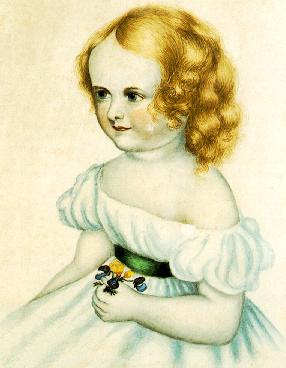
The Brontë’s novels are full of powerful friendships – perhaps the greatest of all being that between Shirley Keeldar and Caroline Helstone in Charlotte Brontë’s second published novel ‘Shirley’. These characters are at least partly based upon Emily and Anne Brontë, and their friendship was a strong one. It was the closest bond in Emily’s life, and summed up perfectly in the greatest tribute to friendship in any work by the Brontës. I leave you with Emily Brontë’s poem ‘Love And Friendship’:
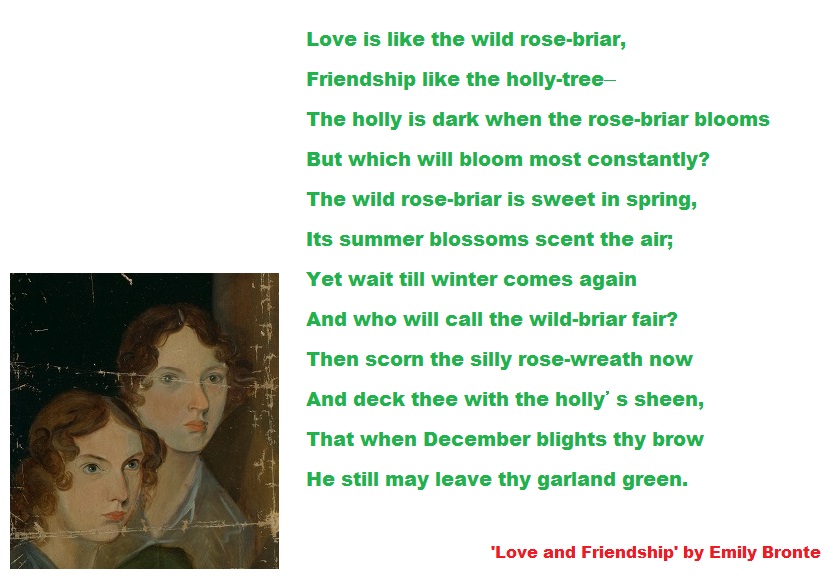
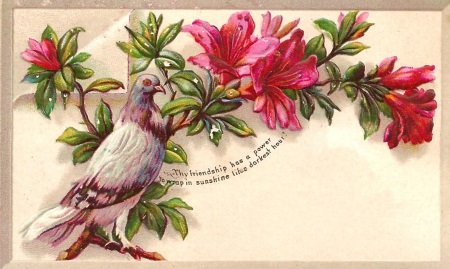
Wow it is incredible to see something from Maria. It is really unfortunate that she died so young; she seems to have been a truly good person. It seems that Anne was most similar to Maria in this regard, as compared to Charlotte and Emily.